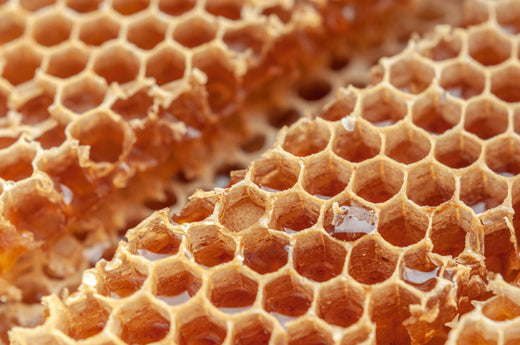Honey, with its rich flavour and natural sweetness, is a staple in many households. However, over time, you may notice your once-smooth honey becoming grainy or solidified—a process known as crystallization. While crystallised honey is perfectly safe to eat and some even prefer its texture, many wonder how to return it to its liquid state. This guide will walk you through the process, answer common questions, and provide tips to maintain honey's smooth consistency.
Why Does Honey Crystallise?
Honey is a supersaturated solution, primarily composed of sugars like glucose and fructose. Over time, glucose can separate from water, forming crystals. Factors influencing this process include:
● Temperature: Cooler storage temperatures accelerate crystallisation.
● Honey Composition: Higher glucose-to-fructose ratios lead to quicker crystallisation.
● Pollen and Particles: Natural particles in raw honey can act as nucleation points for crystals.
It's essential to note that crystallisation is a natural process and doesn't indicate spoilage. Properly stored honey can remain safe to consume indefinitely.
Methods to Decrystallize Honey
If you prefer your honey in a liquid form, several methods can help you achieve this:
1. Warm Water Bath
What is the easiest way to decrystallize honey? A warm water bath is one of the simplest and most effective methods.
Steps:
● Prepare the Container: Ensure your honey is in a heat-safe, glass container. If it's in a plastic bottle, consider transferring it to a glass jar to prevent deformation.
● Heat the Water: Fill a pot with water and heat it to a temperature between 95°F to 110°F (35°C to 43°C). Avoid boiling water, as excessive heat can degrade honey's beneficial enzymes and alter its flavor.
● Submerge the Jar: Place the honey jar in the warm water, ensuring the water level is below the lid to prevent contamination.
● Stir Occasionally: Gently stir the honey every few minutes to distribute heat evenly.
● Monitor the Process: Within 20–30 minutes, the crystals should dissolve, returning the honey to its liquid state.
2. Slow Cooker Method
For larger quantities of honey, a slow cooker offers a hands-off approach.
Steps:
● Set the Temperature: Adjust your slow cooker to the 'low' or 'warm' setting, ensuring it doesn't exceed 110°F (43°C).
● Add Water: Pour enough water into the cooker to reach halfway up the sides of the honey jar.
● Place the Jar: Remove the honey jar's lid and set it in the slow cooker.
● Cover and Wait: Allow the honey to warm for 2–3 hours, checking periodically.
● Stir if Necessary: For even heating, stir the honey occasionally.
3. Microwave Method
While convenient, this method requires caution to prevent overheating.
Steps:
● Transfer Honey: Pour the crystallized honey into a microwave-safe glass container.
● Set Power Level: Adjust the microwave to medium or 50% power to avoid overheating.
● Heat in Intervals: Microwave the honey in 15–20 second bursts.
● Stir Between Intervals: After each burst, stir the honey to distribute heat evenly.
● Repeat as Needed: Continue until the honey reaches the desired consistency.
● Caution: Overheating can degrade honey's quality. Always use moderate heat and avoid prolonged exposure to high temperatures.
Frequently Asked Questions
How Do You Turn Crystallised Honey Back to Liquid?
To revert crystallised honey to liquid, gently heat it using methods like a warm water bath, slow cooker, or microwave, ensuring temperatures remain below 110°F (43°C) to preserve its natural properties.
How Many Times Can You Decrystallize Honey?
Honey can be decrystallized multiple times without significant loss of quality. However, repeated heating may slightly affect its flavor and nutritional content. To minimise the need for frequent decrystallization, store honey in a warm area and avoid introducing moisture, which can promote crystallisation.
Is Crystallized Honey Safe to Eat?
Yes, crystallised honey is safe to consume. The crystallization process is natural and doesn't indicate spoilage. Some individuals even prefer the texture of crystallised honey, especially when spread on toast or biscuits.
Can You Prevent Honey from Crystallising?
While it's challenging to prevent crystallisation entirely, you can slow the process by:
- Storing at room temperature, ideally between 70°F to 80°F (21°C to 27°C).
- Using airtight containers
- Avoiding refrigeration
Does the Type of Honey Affect Crystallisation?
Yes, the botanical source of honey influences its crystallisation rate. Honeys with higher glucose content crystallise faster than those with higher fructose levels.
Conclusion
Crystallisation is a natural characteristic of honey and doesn't diminish its quality or safety. By understanding the factors that contribute to this process and employing gentle heating methods, you can easily restore honey to its liquid form. Remember to store honey properly to delay crystallization and enjoy its sweet benefits for an extended period.
References
Taste of Home (2024). How to Decrystallize Honey the Easy Way. Retrieved from https://www.tasteofhome.com/article/how-to-decrystallize-honey/
Sioux Honey. 3 Simple Steps to Decrystallize Honey. Retrieved from https://siouxhoney.com/3-simple-steps-to-decrystallize-honey/#
Real Simple (2024). Is Crystallized Honey Safe to Eat—and Does It Actually Go Bad? Retrieved from https://www.realsimple.com/is-crystallized-honey-safe-to-eat-8714568

